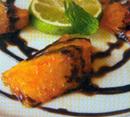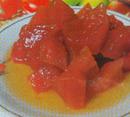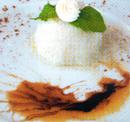Pastries and Desserts; Fruits and Sugar
It's all about the Caribbean and its rich variety of tongues and races. Everything has to do with the region's nature. It's a multiplicity of dances and sounds. It's its universal heritage of race breeding and cultures what makes everything happen in this neck of the woods.
Caribbean food boasts a blend of European and African dishes, marked to a lesser degree by contributions from Chinese and Arabic cuisines. Pastries, combinations of tasty fruits and sugar milled out of cane are landmark products of the region.
This god-sent alchemy shows off hundreds of recipes that have been thoroughly handed down from one generation to the next through centuries and enhanced by those gifted with cooking skills.
The combination of these ingredients is welcome news at any time, though desserts are usually saved for the end of each meal. There are even some countries where no dinner, no matter how humble it might be, can be alright unless you wrap it up with some sugar-based dessert. Some Cuban regions are good cases in point.
The liking toward this kind of dish is so ingrained in our consciousness, that we make extensive use of words like sugar and sweet when referring to nice things, whether it's a look, a way of speaking, a gait, a beautiful pair of fleshy lips… you name it!
Even insipid foodstuffs that dominate sugarless cuisine could be whipped into sweeter-than-sweet shapes. And there are cases galore in the Caribbean, such as the majarete (made of corn), rice custard, sweet bean paste, potato or cassava fritters dipped in syrup and lots of other homemade desserts.
We cannot list the names of all regional desserts because my editor-in-chief would kill me. And the heart of the matter is that the same dessert or sweet dish can run under a different moniker in different parts of the Caribbean, either out their linkage with its manufacturers, with local occurrences from the past or larger-than-life characters. I think the best we can do is talk about their main ingredients, common to all of them out of weather coincidences.
The Main Ingredients There are hundreds of formulas based on the use of fruits. In the realm of so-called homemade desserts, papaya holds a number of combinations, green or ripe, harder or softer, sliced in cubes or in jam. The queen of all fruits, at least in Cuba where most people do have a sweet tooth, is guava, nicknamed here the “kitchen gossiper.”
Its strong aroma gives the cook away and the entire neighborhood knows for sure what you're doing back there. Either in jam or in peerless halves, accompanied by white or cheddar cheese, this fruit packs a punch to the most demanding senses. When shaped in bars –it becomes harder and with better consistency- guava is simply irresistible. Besides, you make use of everything about this fruit, both the kernel and the skin. The two sides of sour oranges and grapefruits are used for making yummy desserts, too. And don't you forget about banana, tamarind, mango, pineapple, watermelon, cashew, fig, honeyberry, mamey and plum.
Other foodstuffs provide similar dessert recipes. Sweet potato, though with an ingrained sweet touch of its own, is boiled in sugar and water to make an exquisite paste. Cooks sometimes let that paste take a slow burn for a longer time to make it harder. A sprinkle of ground cinnamon is the perfect finishing touch. The meat of the coconut can be grated and boiled until it hardens. Then you add some brown sugar and bingo! You've got grated coconut dipped in syrup. Pumpkin, cassava, cornmeal, potato, sweet potato, rice and beans also double in brass in the kitchen.
Milk is a blessing in shapes and names when turned into some sweet stuff. Bread puddings with nutty fruits are commonplace in many Caribbean regions. You beat eggs and sugar, and custards are born. And pouring some grated coconut all over them won't be a bad case of putting icing on the cake. Custards can also be made out of pumpkin and covered in hardened syrup.
As to honey and sugar coated sweets that kids crave the most, candies, taffy, nougats and grated coconut take the cake, let alone chocolate, a crop that came here to stay and shack up with sugar for good.
Your sweet's here, baby Package is as important as flavor is, make no mistakes about it. The usual practice is to have good-looking girls push a cart full of candies and treats around tables in cafeterias, the same delicacies customers had ducked past the showcases as they walked in the place. But the moment you take a closer look at them and see their well-defined layers, the motley marshmallow, the short-lived decorations that melt in the mouth in no time, can you resist that temptation? I bet you can't
Street peddlers are similarly good allies of candies and sweets. Many of these vendors cry out their goods as they go hawking up and down the streets. And sometimes their cries are so well crafted that they lay bare the quirks of these lands.
In short, the history of a region can also be told by its cuisine. In the case of sweets, we take advantage of the quantity and diversity of natural products, imagination and the contribution of the whole culture that we inherited from our ancestors, either for the better or for the worse.




































































